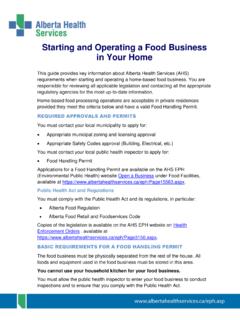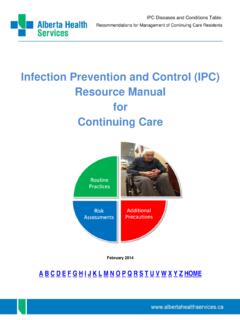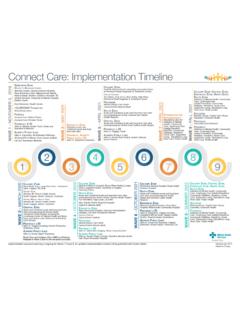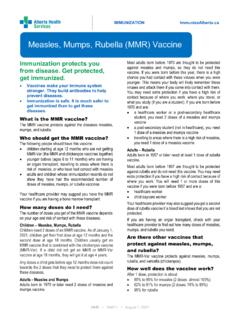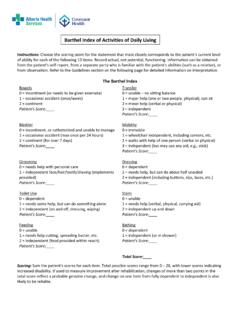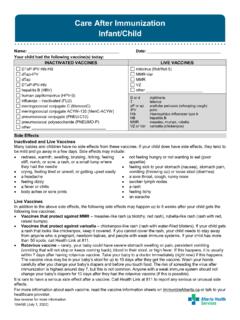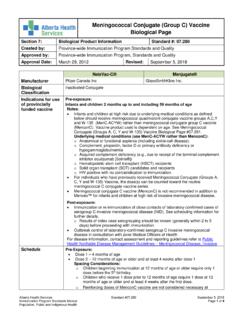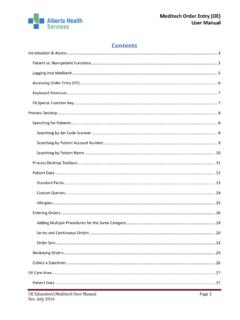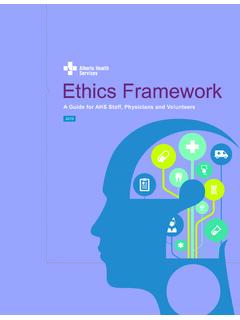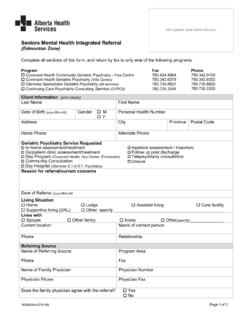Transcription of Meningococcal B Multicomponent - Alberta Health Services
1 Alberta Health Services Standard # May 4, 2022 Immunization Program Standards Manual Page 1 of 5 Provincial Population and Public Health Meningococcal B Multicomponent Recombinant Vaccine Biological Page Section 7: Biological Product Information Standard #: Created by: Province-wide Immunization Program, Standards and Quality Approved by: Province-wide Immunization Program, Standards and Quality Approval Date: January 1, 2015 Revised: May 4, 2022 Bexsero Manufacturer GlaxoSmithKline Inc. Biological Classification Multicomponent Recombinant, adsorbed. Indications for Provincially Funded Vaccine Individuals 2 months of age and older: Pre-exposure: Individuals at high risk of invasive Meningococcal disease (IMD) due to the following underlying medical conditions: o Asplenia anatomical or functional (including sickle-cell disease).
2 O Acquired complement deficiencies , due to receipt of the terminal complement inhibitor eculizumab (Soliris ). Note: Individuals prescribed eculizumab (Soliris ) should receive Meningococcal vaccine at least two weeks before receiving the first dose of Soliris if possible. o Congenital complement, properdin, factor D deficiency or primary antibody deficiencies. o HIV infection. Research, industrial and clinical laboratory personnel routinely exposed to N. meningitidis . Includes only laboratory personnel involved in conducting subculture identification , susceptibility testing, serological and/or molecular characterization and deep freeze for storage. Laboratory workers who do only initial specimen plants are not eligible. Meningococcal disease outbreaks caused by serogroup B N.
3 meningitidis or the emergence of hyperendemic and/or hypervirulent N. meningitidis strains that are predicted to be susceptible based on Meningococcal Antigen Typing System (MATS) testing. Post-exposure: Identified household and close contacts of laboratory confirmed cases of Meningococcal serogroup B invasive Meningococcal disease (IMD) Note: Results of index case serogroup should be confirmed (generally within 2 to 5 days) before proceeding with immunization For disease information, contact assessment and reporting guidelines refer to Public Health Notifiable Disease Management Guidelines - Meningococcal Disease, Invasive. Schedule Pre-exposure: 2 months up to and including 5 months of age (3 doses): o Dose 1: 2 months of age o Dose 2: 4 months of age o Dose 3: 12 months of age or older with a minimum of 6 months from the second dose Note: Interval between the first two doses must be at least 8 weeks.
4 If the interval between the first two doses is less than 8 weeks, a third dose should be given at least 4 Alberta Health Services Standard # May 4, 2022 Immunization Program Standards Manual Page 2 of 5 Provincial Population and Public Health Bexsero weeks after the second dose and a fourth dose in the second year of life with an interval of at least 6 months from the third dose. 6 months up to and including 11 months of age (3 doses): o Dose 1: Day 0 o Dose 2: at least 8 weeks after dose 1 o Dose 3: 12 months of age or older with a minimum of at least 8 weeks after dose 2 12 months of age up to and including 23 months of age (2 doses): o Dose 1: Day 0 o Dose 2: at least 8 weeks after dose 1 2 years of age and older (2 doses): o Dose 1: Day 0 o Dose 2: at least 4 weeks after dose 1 Booster doses: recommended every 3 to 5 years for individuals who remain on eculizumab (Soliris ).
5 6 years of age or younger at time of initial immunization: administer a booster dose three years after the last dose followed by a booster dose every five years. 7 years of age and older at time of initial immunization: administer a booster dose every five years. Note: It is recommended that routine prophylactic acetaminophen be considered for preventing fever in infants and children up to three years of age. Post exposure: Close contacts (as defined in the Public Health Notifiable Disease Management Guidelines - Meningococcal Disease, Invasive) are recommended to receive post-exposure vaccine. No previous Bexsero vaccine: 2 months up to and including 5 months of age (4 doses): o Dose 1: as soon as possible after exposure o Dose 2: 4 weeks after dose 1 o Dose 3: 4 weeks after dose 2 o Dose 4: at least 12 months of age or older and at least 4 weeks after dose 3 Note: The fourth dose should be administered early in the second year of life 6 months up to and including 10 years of age (3 doses): o Dose 1: as soon as possible after exposure o Dose 2: 8 weeks after dose 1 o Dose 3: at 12 months of age and at least 8 weeks after dose 2 11 years of age and older (2 doses): o Dose 1: as soon as possible after exposure o Dose 2: 4 weeks after dose 1 Previously immunized with Bexsero vaccine.
6 2 months of age and older One dose post-exposure if: o The last dose of vaccine was given prior to one year of age and more than 4 weeks has passed since their last dose; OR o They have an underlying medical condition that puts them at risk for Meningococcal group B disease and more than 4 weeks has passed since their last dose of vaccine; OR o They have no underlying medical condition that puts them at risk for Meningococcal group B disease, and the last dose of vaccine was given after 1 year of age and more than one year has passed since their last dose. Complete series as necessary. Alberta Health Services Standard # May 4, 2022 Immunization Program Standards Manual Page 3 of 5 Provincial Population and Public Health Bexsero Notes: Routine prophylactic acetaminophen and /or separating Bexsero vaccine from routine immunization schedules may be considered for preventing fever in children up to 3 years of age.
7 Preferred Use N/A Dose mL Route IM Contraindications/ Precautions Contraindications: Known severe hypersensitivity to any component of the vaccine. Anaphylactic or other allergic reactions to a previous dose of this vaccine or to a vaccine containing similar components. Precautions: Protection against all circulating Meningococcal serogroup B strains is not expected. Possible Reactions Common: Injection site pain, tenderness, erythema, induration and swelling. Infants and children less than 2 years of age: change to eating habits, vomiting, diarrhea, sleepiness, irritability, rash (urticarial), unusual crying, and fever. Fever was more frequently reported following immunization with Bexsero administered simultaneously with routine vaccines.
8 O Children experiencing fever after preceding doses have a higher probability of developing fever after subsequent doses. o Fever rates are lower with increasing age. Children 2 years of age up to and including 10 years of age: change to eating habits, sleepiness, vomiting, diarrhea, irritability, headache, arthralgia, rash, fever. Adolescents and adults: headache, malaise, myalgia, arthralgia, fever, nausea. Uncommon: Infants and children (2 months of age to 10 years of age): urticaria, eczema, seizures (including febrile seizures), pallor. Rare: Infants and children (2 months of age to 10 years of age): Kawasaki syndrome. Anaphylaxis. The following additional adverse events have been reported from post-marketing surveillance: blisters at or around the injection site, injection site nodule hypotonic-hyporesponsive episode.
9 Pregnancy Adequate data is not available for the use of Men-B vaccine during pregnancy. However, in post exposure situations, the vaccine should be administered. Lactation Can be administered to eligible breastfeeding women Composition Each mL dose of vaccine contains: 50 mcg recombinant Neisseria meningitidis serogroup B NHBA (Neisseria Heparin Binding Antigen) fusion protein. 50 mcg recombinant Neisseria meningitidis serogroup B NadA (Neisseria adhesin A) protein. 50 mcg recombinant Neisseria meningitidis serogroup B fHbp (factor H binding protein) fusion protein. 25 mcg outer membrane vesicles (OMV) from Neisseria meningitidis serogroup B strain NZ98/254 measured as amount of total protein containing the PorA Produced in E. coli by recombinant DNA technology.
10 Alberta Health Services Standard # May 4, 2022 Immunization Program Standards Manual Page 4 of 5 Provincial Population and Public Health Bexsero Adsorbed on aluminum hydroxide. NHBA (Neisserial Heparin Binding Antigen), NadA (Neisseria adhesin A), fHbp (factor H binding protein). Sodium chloride. Histidine. Sucrose. Water for injection. Residue from manufacturing process: kanamycin. Blood/Blood Products No blood products are used. Bovine/Porcine Products Bovine and porcine products are used as raw materials during the manufacturing process. Latex Tip cap of syringe may contain natural rubber latex. Interchangeability N/A Administration with Other Products Prophylactic acetaminophen should only be recommended for infants and children up to 3 years of age when other vaccines will be given.
